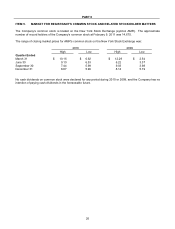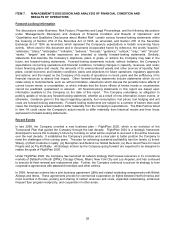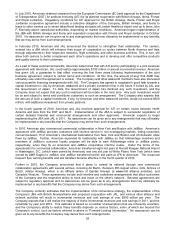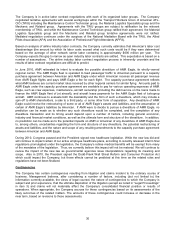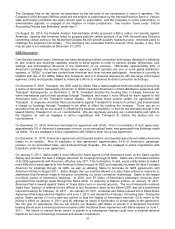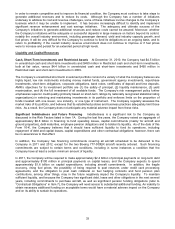American Airlines 2010 Annual Report Download - page 38
Download and view the complete annual report
Please find page 38 of the 2010 American Airlines annual report below. You can navigate through the pages in the report by either clicking on the pages listed below, or by using the keyword search tool below to find specific information within the annual report.
35
In 2008, the Company entered into a new purchase agreement with Boeing for the acquisition of 42 firm Boeing
787-9 aircraft and purchase rights to acquire up to 58 additional B787 aircraft. Per the purchase agreement, the
first such aircraft was scheduled to be delivered in 2012, and the last firm aircraft was scheduled to be delivered
in 2018 with deliveries of additional aircraft, if any, scheduled between 2015 and 2020. In July 2010, the
Company and Boeing agreed upon a revised delivery schedule due to the impact of the overall Boeing 787
program delay on American’s delivery positions. The first aircraft is currently scheduled to be delivered in 2014,
and the last firm aircraft is scheduled to be delivered in 2018 with deliveries of additional aircraft, if any, scheduled
between 2016 and 2021. Additionally, the revised delivery schedule includes terms and conditions consistent with
the original agreement and allows the Company the confirmation rights described below.
Under the current 787-9 purchase agreement and supplemental agreement, except as described below,
American will not be obligated to purchase a 787-9 aircraft unless it gives Boeing notice confirming its election to
do so at least 18 months prior to the scheduled delivery date for that aircraft. If American does not give that
notice with respect to an aircraft, the aircraft will no longer be subject to the 787-9 purchase agreement. These
confirmation rights may be exercised until a specified date (May 1, 2014 under the current agreement) provided
that those rights will terminate earlier if American reaches a collective bargaining agreement with its pilot union
that includes provisions enabling American to utilize the 787-9 to American’s satisfaction in the operations desired
by American, or if American confirms its election to purchase any of the initial 42 787-9 aircraft. While there can
be no assurances, American expects that it will have reached an agreement as described above with its pilots
union prior to the first notification date. In either of those events, American would become obligated to purchase
all of the initial 42 aircraft then subject to the purchase agreement. If neither of those events occurs prior to the
specified date (May 1, 2014 under the current agreement) then on that date American may elect to purchase all of
the initial 42 aircraft then subject to the purchase agreement, and if it does not elect to do so, the purchase
agreement will terminate in its entirety.
Credit Ratings AMR’s and American’s credit ratings are significantly below investment grade. Additional
reductions in AMR's or American's credit ratings could further increase the Company’s borrowing or other costs
and further restrict the availability of future financing.
Credit Card Processing and Other Reserves American has agreements with a number of credit card
companies and processors to accept credit cards for the sale of air travel and other services. Under certain of
these agreements, the credit card processor may hold back a reserve from American’s credit card receivables
following the occurrence of certain events, including the failure of American to maintain certain levels of liquidity
(as specified in each agreement).
Under such agreements, the amount of the reserve that may be required generally is based on the processor’s
exposure to the Company under the applicable agreement and, in the case a reserve is required because of
AMR’s failure to maintain a certain level of liquidity, the amount of such liquidity. As of December 31, 2010, the
Company was not required to maintain any reserve under such agreements. If circumstances were to occur that
would allow the credit card processor to require the Company to maintain a reserve, the Company’s liquidity
would be negatively impacted.
Cash Flow Activity The Company’s cash flow from operating activities during the year ended December 31,
2010 generated $1.2 billion, which is an increase of $311 million from the same period in 2009 primarily due to an
improved revenue environment in 2010 as compared to 2009.
The Company made debt and capital lease payments of $1.2 billion in 2010 while capital expenditures during
2010 were $2.0 billion and primarily included new aircraft and aircraft modifications. Substantially all of the
aircraft were financed through previously arranged financing transactions.
Due to the current value of the Company’s derivative contracts, some agreements with counterparties require
collateral to be deposited by the counterparty. As of December 31, 2010, the cash collateral held by AMR from
such counterparties was $73 million as compared to $14 million held by such counterparties at December 31,
2009. Cash held at December 31, 2010 from counterparties is included in short-term investments. As a result of
movements in fuel prices, the cash collateral amounts held by AMR or the counterparties to such contracts, as the
case may be, can vary significantly.
In the past, the Company has from time to time refinanced, redeemed or repurchased its debt and taken other
steps to reduce its debt or lease obligations or otherwise improve its balance sheet. Going forward, depending on
market conditions, its cash positions and other considerations, the Company may continue to take such actions.



